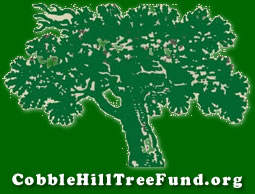REQUEST A TREE
HOW MUCH DOES A TREE COST?
Currently the average cost ranges from $1200 to $2100 PLUS stump if required, and tree bed expansion if required. The Fund will normally cover one half of the cost, and make arrangements.These costs are also tax deductible.
Currently the average cost ranges from $1200 to $2100 PLUS stump if required, and tree bed expansion if required. The Fund will normally cover one half of the cost, and make arrangements.These costs are also tax deductible.
BY NEW YORK CITY LAW, TREES MAY NOT BE PLANTED IN THE FOLLOWING LOCATIONS:
• within 20’-30’ of another tree
• 3’ between the edge of the tree bed and a fire hydrant
• gas or water valve to the edge of the bed is 2 feet
• Minimum distance from the corner of a street intersection to the tree trunk is 40 feet.
• within a bus stop
If you are unsure about the site, the Fund will be pleased to help you. Normally, by Mid-December the new trees will have been planted. If the site has a tree pit with a stump, please contact us.
HOW TO OBTAIN A STREET TREE
There are three ways to get a tree:
1. REQUEST A FREE TREE FROM THE PARKS DEPARTMENT, THROUGH COMMUNITY BOARD 6.
a) Obtain a Street Tree Planting Form from the Community Board or from its website.
b) Or, call Community Board 6 at (718) 643-3027 and request they send you a form. Submit the completed form to CB-6. (Requests are collected and sent to the Parks Department where they are prioritized. The priority depends upon Parks’ planting schedule.)
Note: The advantage of this approach is that there is no cost. The disadvantages are: There is no assurance that the requested tree-type will be planted. Delays of 12 to 18 months are possible according to CB-6 and the Parks Dept.
2. OBTAINING A TREE THROUGH THE COBBLE HILL TREE FUND
The CHTF will discuss appropriate tree-types with the building owner and the CHTF will obtain the agreed upon tree. The CHTF will supervise the planting which will be done by a Parks Dept. approved nursery and guaranteed for one year. The CHTF will obtain a permit from the Parks Department
Note: The advantage of this is the potential delay is minimized and the homeowner will have more choice of trees. The main disadvantage is that there will be an out-of-pocket cost. This cost is moreover deductible as a charitable contribution.
The Cobble Hill Tree Fund is happy to provide advice on appropriate tree-types, obtaining a permit, and tree care. To obtain more information and permit forms, contact the CHTF.
3. OBTAINING A TREE THROUGH THE NEW YORK TREE TRUST PROGRAM
If anyone wants to donate trees to be planted on the street or in selected NYC Parks, the process is very simple, this is a 501(c)(3), tax-deductible donation to City Parks Foundation, fiscal sponsor of the New York Tree Trust. They cannot guarantee planting the exact species in the exact spot that a donor selects, but they will do their best to accommodate given the existing conditions.
There are three ways to get a tree:
1. REQUEST A FREE TREE FROM THE PARKS DEPARTMENT, THROUGH COMMUNITY BOARD 6.
a) Obtain a Street Tree Planting Form from the Community Board or from its website.
b) Or, call Community Board 6 at (718) 643-3027 and request they send you a form. Submit the completed form to CB-6. (Requests are collected and sent to the Parks Department where they are prioritized. The priority depends upon Parks’ planting schedule.)
Note: The advantage of this approach is that there is no cost. The disadvantages are: There is no assurance that the requested tree-type will be planted. Delays of 12 to 18 months are possible according to CB-6 and the Parks Dept.
2. OBTAINING A TREE THROUGH THE COBBLE HILL TREE FUND
The CHTF will discuss appropriate tree-types with the building owner and the CHTF will obtain the agreed upon tree. The CHTF will supervise the planting which will be done by a Parks Dept. approved nursery and guaranteed for one year. The CHTF will obtain a permit from the Parks Department
Note: The advantage of this is the potential delay is minimized and the homeowner will have more choice of trees. The main disadvantage is that there will be an out-of-pocket cost. This cost is moreover deductible as a charitable contribution.
The Cobble Hill Tree Fund is happy to provide advice on appropriate tree-types, obtaining a permit, and tree care. To obtain more information and permit forms, contact the CHTF.
3. OBTAINING A TREE THROUGH THE NEW YORK TREE TRUST PROGRAM
If anyone wants to donate trees to be planted on the street or in selected NYC Parks, the process is very simple, this is a 501(c)(3), tax-deductible donation to City Parks Foundation, fiscal sponsor of the New York Tree Trust. They cannot guarantee planting the exact species in the exact spot that a donor selects, but they will do their best to accommodate given the existing conditions.
HOW TO OBTAIN A TREE GUARD
The CHTF can provide information on obtaining a tree guard. Please contact us through our Contact Form.
WHY PLANT TREES?
Here are 30 reasons why....
[Excerpted from the USDA Forest Service Pamphlet #R1-92-100]
1. Trees store carbon and clean the atmosphere. In 50 years, one tree can generate $30,000 in oxygen, recycles $35,000 of water, and removes $60,000 in pollution.
2. Trees prevent soil erosion.
3. Trees prevent or reduce water pollution.
4. Trees help recharge ground water and sustain streamflow.
5. Properly placed screens of trees and shrubs decrease traffic noise along busy streets and highways.
6. Trees screen unsightly views and provide privacy.
7. Trees make life more pleasant by softening harsh outlines of buildings.
8. Fast-growing species of trees in energy plantations provide a continuous supply of fuelwood.
9. Properly managed forests provide a sustained supply of lumber, plywood and other wood products.
10. Tree shade reduces air-conditioning costs in residential and commercial buildings by 15 to 50 percent, thereby reducing the need for additional dams, power plants, and nuclear generators.
11. Windbreaks can shield homes against wind and snow, reducing heating costs as much as 30 percent.
12. Sweltering streets and parking lots cool off when trees shade them. Cities are "heat islands" 5 to 9 degrees warmer than surrounding areas.
13. Properly placed and cared for trees and shrubs significantly increase residential and commercial property values.
14. Crop yields of fields with windbreaks are significantly higher than those without windbreaks.
15. Farmstead windbreaks reduce cooling and heating utility bills, trap snow, provide wildlife habitat, and simply look nice.
16. Trees provide nutmeats (walnuts, pecans, hickory), fruit (plums, peaches, apples, pears), berries for jams and jellies, and sap for maple syrup.
17. Tree shelters for livestock can reduce weight losses during cold winter months and provide shade for modrating heat stress in summer.
18. Living snowfences, strategically placed, hold snow away form roads, reducing maintenance costs.
19. Trees add beauty and grace to any community setting. They make life more enjoyable, peaceful and relaxing.
20. Tropical forests offer great healing value. One of every four pharmaceutical products used in the U.S. comes from tropical forest plants.
21. Native trees in the U.S. yield substances for pharmaceutical and other medical purposes. Taxol, a substance from yew trees, shows promise for treating certain kind of cancer.
22. Trees provide a multitude of recreation opportunities.
23. Trees provide habitat for a large variety of wildlife.
24. Trees along rivers, streams, and lakes reduce water temperature and prevent or reduce bank erosion and silt. Their roots provide hiding places for fish.
25. Trees add brilliant colors to tall landscapes and, following the dropping of the leaves, provide excellent garden mulch.
26. Research shows that trees help reduce stress in the workplace and speed the hospital patients' recovery.
27. Police officers believe that trees and landscaping can instill community pride and help cool tempers that sometimes erupt during long, hot summers.
28. Trees connect us with nature and reinforce spiritual and cutural values.
29. Trees, planted as memorials, leave a valuable gift for future generations.
30. Many people plant and care for trees because they enjoy watching them grow.
The CHTF can provide information on obtaining a tree guard. Please contact us through our Contact Form.
WHY PLANT TREES?
Here are 30 reasons why....
[Excerpted from the USDA Forest Service Pamphlet #R1-92-100]
1. Trees store carbon and clean the atmosphere. In 50 years, one tree can generate $30,000 in oxygen, recycles $35,000 of water, and removes $60,000 in pollution.
2. Trees prevent soil erosion.
3. Trees prevent or reduce water pollution.
4. Trees help recharge ground water and sustain streamflow.
5. Properly placed screens of trees and shrubs decrease traffic noise along busy streets and highways.
6. Trees screen unsightly views and provide privacy.
7. Trees make life more pleasant by softening harsh outlines of buildings.
8. Fast-growing species of trees in energy plantations provide a continuous supply of fuelwood.
9. Properly managed forests provide a sustained supply of lumber, plywood and other wood products.
10. Tree shade reduces air-conditioning costs in residential and commercial buildings by 15 to 50 percent, thereby reducing the need for additional dams, power plants, and nuclear generators.
11. Windbreaks can shield homes against wind and snow, reducing heating costs as much as 30 percent.
12. Sweltering streets and parking lots cool off when trees shade them. Cities are "heat islands" 5 to 9 degrees warmer than surrounding areas.
13. Properly placed and cared for trees and shrubs significantly increase residential and commercial property values.
14. Crop yields of fields with windbreaks are significantly higher than those without windbreaks.
15. Farmstead windbreaks reduce cooling and heating utility bills, trap snow, provide wildlife habitat, and simply look nice.
16. Trees provide nutmeats (walnuts, pecans, hickory), fruit (plums, peaches, apples, pears), berries for jams and jellies, and sap for maple syrup.
17. Tree shelters for livestock can reduce weight losses during cold winter months and provide shade for modrating heat stress in summer.
18. Living snowfences, strategically placed, hold snow away form roads, reducing maintenance costs.
19. Trees add beauty and grace to any community setting. They make life more enjoyable, peaceful and relaxing.
20. Tropical forests offer great healing value. One of every four pharmaceutical products used in the U.S. comes from tropical forest plants.
21. Native trees in the U.S. yield substances for pharmaceutical and other medical purposes. Taxol, a substance from yew trees, shows promise for treating certain kind of cancer.
22. Trees provide a multitude of recreation opportunities.
23. Trees provide habitat for a large variety of wildlife.
24. Trees along rivers, streams, and lakes reduce water temperature and prevent or reduce bank erosion and silt. Their roots provide hiding places for fish.
25. Trees add brilliant colors to tall landscapes and, following the dropping of the leaves, provide excellent garden mulch.
26. Research shows that trees help reduce stress in the workplace and speed the hospital patients' recovery.
27. Police officers believe that trees and landscaping can instill community pride and help cool tempers that sometimes erupt during long, hot summers.
28. Trees connect us with nature and reinforce spiritual and cutural values.
29. Trees, planted as memorials, leave a valuable gift for future generations.
30. Many people plant and care for trees because they enjoy watching them grow.


